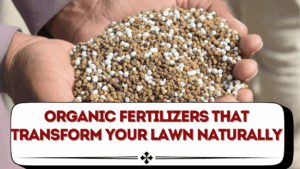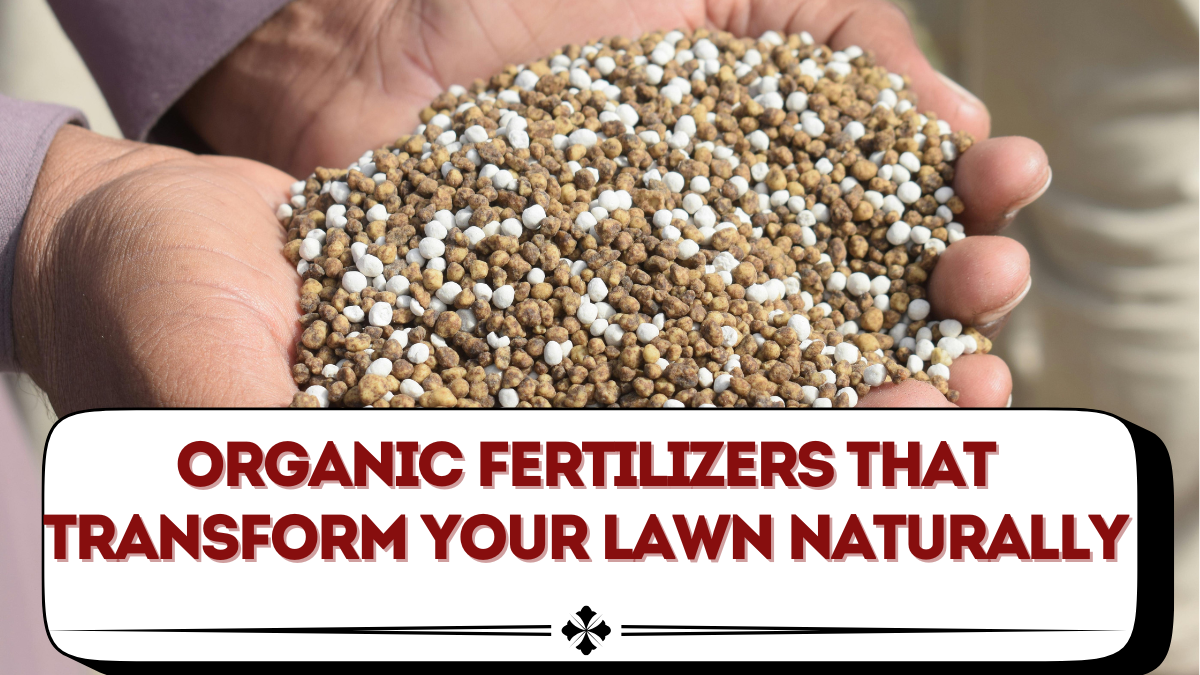Chemical-heavy lawn programs promise instant color but often leave soil biology exhausted, thatch thicker, and watering needs higher. Switching to organic lawn fertilizers flips that script. Organics feed the soil first—microbes, fungi, and earthworms—so your turf develops deeper roots, better drought tolerance, and natural disease resistance. This guide explains the major types of natural fertilizers, how to build a season-by-season plan, the right application rates, and simple brewing tips for compost tea so you can grow a truly eco-friendly lawn without sacrificing curb appeal.

Why choose organic lawn fertilizers
Healthy turf doesn’t come just from nitrogen; it comes from living soil. Organic inputs supply slow-release nutrients bound to carbon, which microbes mineralize steadily so grass gets a consistent, non-burn trickle of N-P-K plus trace minerals. Results you’ll notice:
-
More resilient color that lasts longer between feedings
-
Improved soil structure that holds moisture yet drains well
-
Reduced thatch because microbial life digests dead roots and clippings
-
Safer play areas for kids and pets with no harsh chemical odors
-
Long-term savings as soil fertility builds and inputs decrease
Core types of organic fertilizers
Compost (0.5-1-1 typical)
Well-finished yard, leaf, or food-waste compost adds humus, buffers pH, and inoculates biology. Topdress 0.25–0.5 inch after aeration for maximum contact with the root zone.
Pelletized poultry/composted manures (3-2-3 to 5-4-3)
Uniform, low-odor pellets spread easily and break down over 6–8 weeks. Great for spring green-up and fall root feeding.
Plant-based meals
-
Alfalfa meal (2-1-2): Adds triacontanol, a natural growth stimulant; helps density.
-
Soybean meal (7-1-2): Strong organic nitrogen for steady green without surge.
-
Cottonseed meal (6-2-1): Slightly acidifying; helpful where pH trends high.
Animal-based meals
-
Feather meal (12-0-0): Very slow-release nitrogen—ideal for long, even feeding.
-
Bone meal (3-15-0): Phosphorus and calcium for rooting (use where soil tests show low P).
-
Blood meal (12-0-0): Fast organic N; use sparingly for quick response.
Ocean & mineral inputs
-
Kelp/seaweed extracts: Micronutrients and natural hormones to boost stress tolerance.
-
Fish hydrolysate (2-3-1): Gentle liquid feeding plus microbial food.
-
Greensand & rock phosphate: Slow mineral sources for K and P where tests indicate deficiency.
-
Biochar: Not a fertilizer but a long-lived carbon sponge that improves CEC and moisture retention.
Quick comparison of popular organic options
| Product | Typical N-P-K | Best For | Release Speed | Notes |
|---|---|---|---|---|
| Compost (topdress) | ~0.5-1-1 | Soil structure & biology | Slow | Apply 0.25–0.5″ after aeration |
| Pelletized poultry manure | 4-3-3 (avg) | Spring & fall feedings | Medium | Broad, steady response |
| Soybean meal | 7-1-2 | Season-long N source | Medium | Great base fertilizer |
| Feather meal | 12-0-0 | Long, even N trickle | Slow | Pair with faster N if needed |
| Fish + kelp (liquid) | 2-3-1 | In-season foliar boosts | Fast | Tank-mix friendly |
| Bone meal | 3-15-0 | Rooting & establishment | Medium | Use only if soil P is low |
| Alfalfa meal | 2-1-2 | Density & microbial food | Medium | Adds growth stimulant |
Building a seasonal organic feeding plan
Cool-season lawns (fescue, rye, Kentucky bluegrass)
-
Early spring (soil 10–12°C): Light feed with pelletized manure or soybean meal at 0.5 lb N/1,000 sq ft; spot-spray fish+kelp after mowing starts.
-
Late spring: Compost tea foliar every 3–4 weeks during stress buildup; keep granular N modest to avoid surge growth.
-
Late summer/early fall: Core aerate, topdress 0.25–0.5″ compost, overseed if needed, then apply soybean or feather meal to 0.75 lb N/1,000 sq ft.
-
Late fall (last mow): Potassium-leaning organic (e.g., 3-0-3 or kelp) to harden off before winter.
Warm-season lawns (Bermuda, Zoysia, St. Augustine)
-
Late spring (green-up): 0.5–0.75 lb N/1,000 from soybean/poultry pellets; add kelp for stress tolerance.
-
Mid-summer: Spoon-feed with fish+kelp or a light granular (0.25–0.5 lb N/1,000) if color fades.
-
Early fall: Feather meal or low-salt manure for root reserves; stop heavy N before dormancy.
Application rates and best practices
-
Granular organics: A common seasonal target is 2.5–3.5 lb of actual N per 1,000 sq ft spread across the growing season (adjust by species and clippings return). Most products list a spreader setting; water in lightly after application.
-
Compost topdressing: 0.25–0.5 inch equals ~0.75–1.5 cubic yards per 1,000 sq ft. Brush into holes after aeration for superior results.
-
Liquid feeds (fish/kelp): 1–2 oz concentrate per gallon of water for 1,000 sq ft; apply in the cool of day to wet blades but avoid runoff.
-
Clippings: Use a mulching mower to recycle ~1 lb N/1,000 sq ft per season back into the turf naturally.
Compost tea: brew basics for living biology
A well-aerated compost tea can jump-start microbial diversity and help leaves resist disease.
-
Fill a clean bucket or brewer with non-chlorinated water.
-
Add 1–2 cups of high-quality, finished compost per gallon; include a small amount of unsulfured molasses or fish hydrolysate as microbial food.
-
Actively aerate with an aquarium pump and stone for 24 hours (keep temperatures 18–24°C).
-
Strain and apply within 4–6 hours as a foliar spray and soil drench.
-
Clean equipment thoroughly to prevent biofilm buildup.
Avoid anaerobic (stinky) brews; they can harm turf and soil life.
Soil testing, pH, and nutrient balance
Organic programs work best when guided by a soil test every 1–2 years. Most turf thrives at pH 6.0–7.0. If pH is low, consider agricultural lime; if high, elemental sulfur can help nudge pH downward. Remember that organics release nutrients slowly; avoid piling on phosphorus unless tests show deficiency. Track organic matter (goal ~4–6% for many lawns) to gauge progress.
Common mistakes and easy fixes
-
Over-applying nitrogen: Even organics can cause surge growth and disease; stick to seasonal totals.
-
Skipping carbon: Fertilizer without compost/humus improves color but not soil; include compost or biochar.
-
Ignoring watering: Deep, infrequent irrigation (early morning) complements slow-release organics.
-
No aeration: Compaction blocks oxygen; core aerate high-traffic zones annually.
-
Chasing quick fixes: Combine modest fast N (fish/blood) with slow N (feather/soy) for balanced, lasting color.
Eco-friendly add-ons that amplify results
-
Microclover seeding: Blending 2–5% microclover reduces fertilizer needs via natural nitrogen fixation.
-
Wetting agents (yucca): Help water move into hydrophobic soils in summer.
-
Biochar-compost blends: Improve cation exchange capacity and drought resilience.
-
Leaf mulching in fall: Shreds add free carbon and micronutrients; reduces landfill waste.
FAQs
How fast do organic lawn fertilizers show results?
Liquids like fish and kelp can deepen color within days, while granular organics build steady color over 2–4 weeks as microbes mineralize nutrients.
Are organic fertilizers safe for pets and kids?
Yes, when used as directed. Most organics have low salt indexes and no harsh residues; allow granules to be watered in and the lawn to dry before play.
Can I over-fertilize with organics?
It’s harder but possible. Track actual nitrogen applied per 1,000 sq ft and follow label rates to avoid surge growth and thatch.
What’s the best organic for quick green-up?
A light dose of fish hydrolysate or blood meal provides a faster response; pair with feather or soybean meal for sustained feeding.
Does compost tea really help?
When properly aerated and applied fresh, compost tea can enhance leaf microbiology and stress tolerance. It supplements—but doesn’t replace—solid organic fertility.
Do I still need phosphorus or potassium?
Only if a soil test shows deficiency. Many lawns have adequate P and K; excess applications waste money and can harm waterways.
Conclusion
A thriving, eco-friendly lawn starts beneath your feet. By centering your program on organic lawn fertilizers—compost, plant and animal meals, mineral amendments, and living teas—you build a soil engine that feeds turf naturally, reduces watering and chemical dependence, and keeps play areas safer for families and pets. Begin with a soil test, set realistic seasonal N targets, and combine slow-release granules with light liquid boosts. Within a season or two, you’ll see deeper color, denser turf, and a lawn that stays beautiful because its soil is alive.
